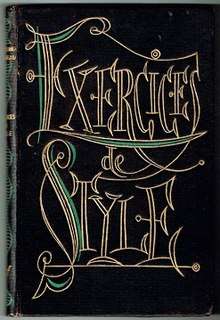Exercises in Style
Exercises in Style (French: Exercices de style), written by Raymond Queneau, is a collection of 99 retellings of the same story, each in a different style. In each, the narrator gets on the "S" bus (now no. 84), witnesses an altercation between a man (a zazou) with a long neck and funny hat and another passenger, and then sees the same person two hours later at the Gare St-Lazare getting advice on adding a button to his overcoat. The literary variations recall the famous 33rd chapter of the 1512 rhetorical guide by Desiderius Erasmus, Copia: Foundations of the Abundant Style.
 1947 hardback edition | |
| Author | Raymond Queneau |
|---|---|
| Original title | Exercices de style |
| Translator | Barbara Wright (English) |
| Illustrator | Mario Prassinos |
| Country | France |
| Language | French |
| Genre | Constrained writing, Fiction |
| Publisher | Gallimard |
Publication date | 1947 |
Published in English | 1958 |
| Media type | |
Translations
The book has been translated into the following languages :
- English by Barbara Wright (1958), with 28 additional Exercises (by Queneau) translated by Chris Clarke and 10 new exercises written in homage (2013)
- Serbian by Danilo Kiš (1964)
- German by Ludwig Harig and Eugen Helmlé (1974)
- Dutch by Rudy Kousbroek (1978)
- Italian by Umberto Eco (1983)[1]
- Greek by Achilleas Kyriakides (1984)
- Czech by Patrik Ouředník (1985)
- Esperanto by István Ertl (1986)
- Swedish by Lars Hagström (1987)
- Hungarian by Róbert Bognár (1988)
- Catalan by Annie Bats and Ramon Lladó (1989)
- Finnish by Pentti Salmenranta (1991)
- Danish by Otto Jul Pedersen (1994)
- Slovene by Aleš Berger (1994)
- Brazilian Portuguese by Luiz Resende (1995)
- Galician by Henrique Harguindey Banet and Xosé Manuel Pazos Varela (1995)
- Japanese by Asahina Koji (1996)
- Norwegian by Ragnar Hovland (1996)
- Spanish by Antonio Fernández Ferrer (1996)
- Russian by V. A. Petrov ed. (1998)
- European Portuguese by Helena Agarez Medeiros ed. (2000)
- Turkish by Armağan Ekici (2003)
- Zurich German by Felix E.Wyss (2004)
- Macedonian by Elizabeta Trpkovska (2005)
- Polish by Jan Gondowicz (2005)
- Basque by Xabier Olarra (2006)
- Romanian by Romulus Bucur ed. (2006)
- Ukrainian by Yaroslav Koval' and Yuriy Lisenko (the poems by Yurka Pozayaka) (2006)
- Bulgarian by Vasil Sotirov and Elena Tomalevska (2007)
- Estonian by Triinu Tamm and Jana Porila (2007)
- Croatian by Vladimir Gerić (2008)
- Traditional Chinese by Tan-Ying Chou (2016)
- Hebrew by Rotem Atar (2016)
- Lithuanian by Akvilė Melkūnaitė (2016)
- Korean by Jae-Ryong Cho (2019)
Because, by their nature, the various retellings of the story employ fine subtleties of the French language, translations into these other languages are adaptations as well as being translations.
Styles employed
The English translation by Barbara Wright (reprinted in paperback in 1981) consists of the tale retold in the following 'styles', where the original has been adapted (rather than translated) the original title is given in italics following :-
|
|
|
|
Other adaptations
- An homage in graphic novel form, 99 Ways to Tell a Story: Exercises in Style by Matt Madden, was published in 2005.
- A typographic interpretation of the German version of Exercices de Style, "Stilübungen – visuelle Interpretationen" by the graphic designer Marcus Kraft, was published in 2006.
- In Croatia (when it was part of SFR Yugoslavia), Tonko Maroević and Tomislav Radić adapted Exercices de Style (transferring the plot from the 1940s Paris to modern Zagreb) into a stage play for two actors, which has been played since 1968. Pero Kvrgić and Lela Margitić, who have been playing the only two roles since January 1970, hold a Guinness World Record for the Longest Theatrical Run with the Same Cast. They received a plaque in 2009.[2]
- Inspired by Queneau's book, the first issue of uprightdown.com (2009) presented a single plot, which was retold in different forms and media by multiple participants.
- Following the formal example of Queneau, Paul Hoover of the United States published Sonnet 56 (2009), which consists of 56 stylistic versions of Shakespeare's sonnet 56, including "Villanelle," "Qasida," "Course Description," and "Ballad."
- Following the example of Queneau, Bethany M. Brownholtz published Exercises in Style: 21st Century Remix (2013), which consists of 40 additional versions, focusing on styles that have emerged over the last 60 years.
- The same story was told in more than hundred new styles in Russian by Tatiana Bonch-Osmolovskaya, Sergey Fedin, Sergey Orlov and others The styles includes combinatorial techniques, contemporary jargons and visuals poems.
References
- Peter E. Bondanella, Andrea Ciccarelli The Cambridge companion to the Italian novel p.169
- "Longest theatrical run - same cast". guinnessworldrecords.com. Guinness World Records. Retrieved 2018-01-10.